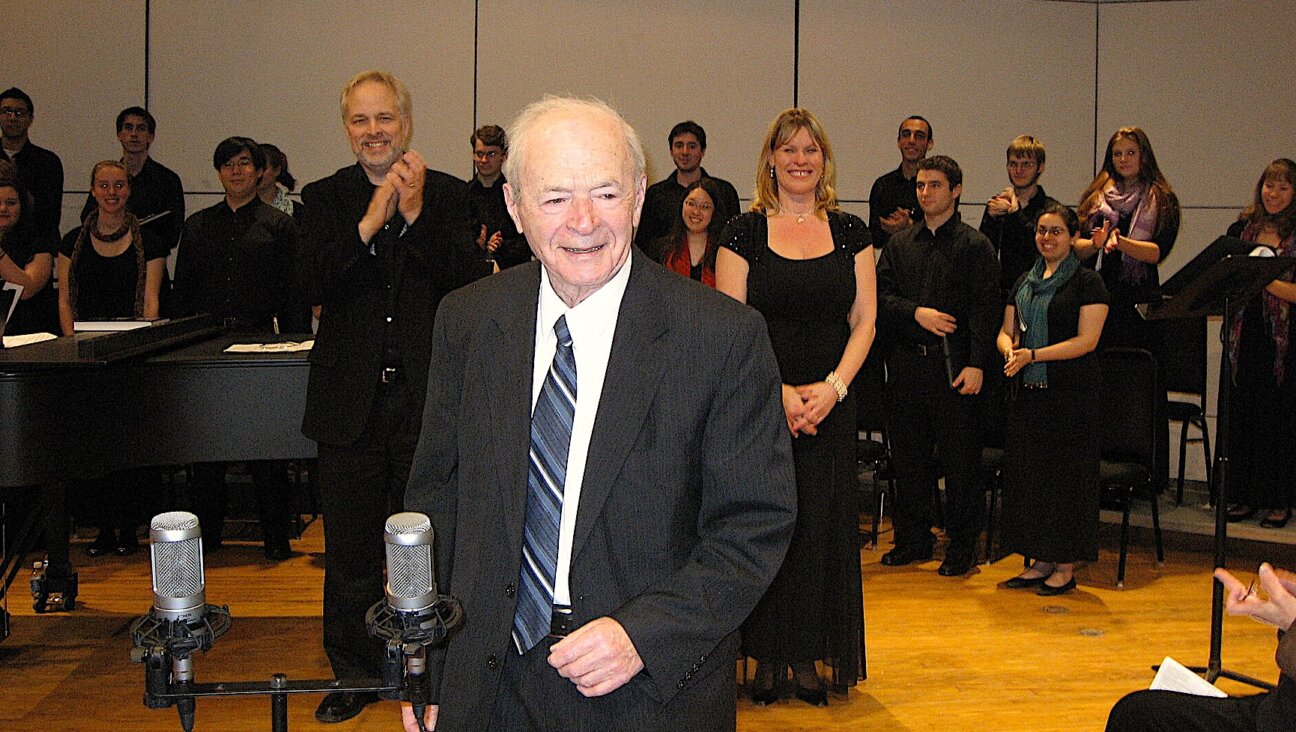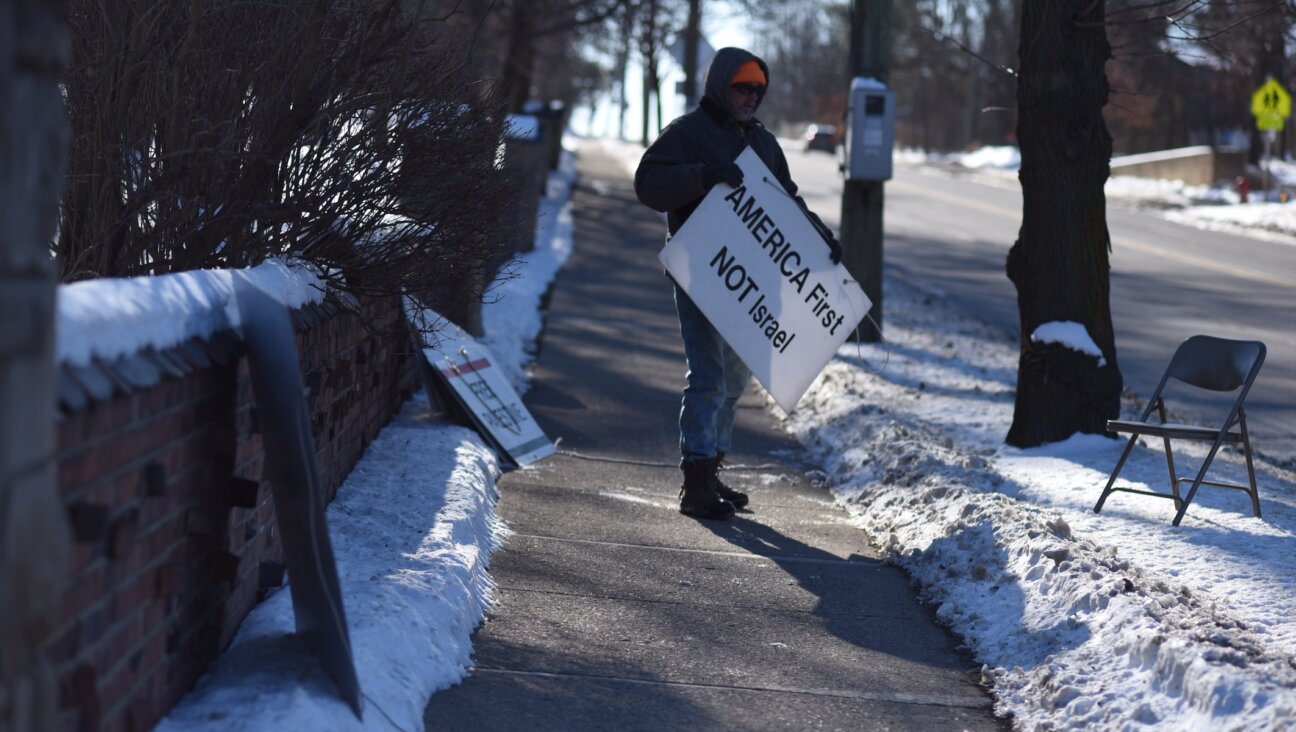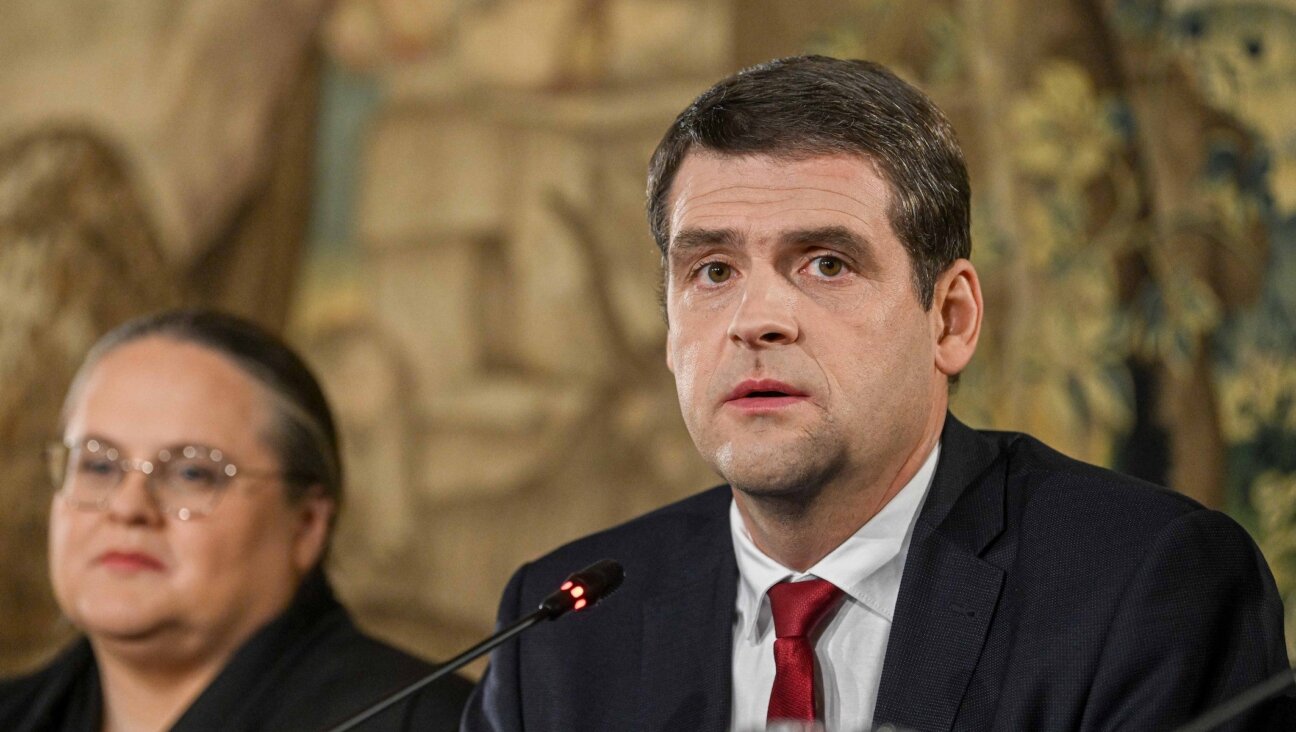It Is Incumbent Upon Us Orthodox Jews To Tell Our Stories

Paula Eiselt during the filming of ‘93Queen’ Image by Courtesy of Paula Eiselt
Paula Eiselt lives between two worlds. It’s not every day that you find a wig-wearing, Orthodox woman behind the camera, appearing at major film festivals, and going to industry parties.
Yet, there she is.
It’s been a year since , ‘93Queen,’ Eiselt’s acclaimed documentary film about Hasidic Judge Ruchie Freier’s women-led ambulance crew, was released — and Eiselt is finally ready to open up about the long journey behind the documentary, and about breaking into the film industry.
“I don’t talk much about being Orthodox,” the petite, dark-haired 33-year old resident of Teaneck, New Jersey tells me on a spring afternoon when we meet at a coffee shop near New York’s Freedom Tower. “I don’t want that to be what defines me. What defines me is my art.”
Eiselt is currently an artist-in-residence at Concordia Studio, a documentary film studio, and is developing her next feature documentary — one that is decidedly not Jewish in theme, but she can’t share more than that at this point. “I don’t want to be only making films on Jewish subjects, but at the same time, I won’t purposely ‘boycott’ my community just because I don’t want to be niche,” she says. “If I find a story in the Orthodox community, and it’s incredible, I’m going to tell it.”
Eiselt grew up modern Orthodox in Merrick, Long Island, and moved to the Five Towns during high school. While most of her friends’ mothers “lunched,” in her words, Eiselt’s mother, a physician’s assistant, was the women’s health coordinator at Rikers Island for many years. “I grew up with a different model of what religious women could be. My family was very progressive.” She adds, with a laugh, “Not many people in the Five Towns voted Obama twice.”
Her passion for film emerged from a day of playing hooky. One day in high school, Eiselt tells me, she and a friend cut class, went to Blockbuster and rented Darren Aronofsky’s 2000 film “Requiem for a Dream.” After the film ended, she remembers staring at the screen and thinking: “This is insane, but I really want to do this. I want to tell stories.”
Eiselt spent a summer interning at the prestigious Bernard Telsey Casting company, and then two summers working for Aronofsky himself, at his production company in New York. In the spring of her senior year, Eiselt was notified of her early acceptance to NYU’s Tisch School Of The Arts. “My whole grade in Hebrew Academy of the Five Towns and Rockaway (HAFTR) was celebrating with me,” she remembered. “It was a big deal. No one went to film school from yeshiva.”
After spending a gap year studying in a Jerusalem seminary, Eiselt started film school — and as an observant Jew, it wasn’t simple. “You have to make it work,” she says. “All the shoots are over the weekends, so Shabbos is really a problem, but I worked around it.”
Some professors were not particularly accommodating about Jewish observance. One professor told her, she recounts, “‘I hope you’ll take your work as seriously as you take your religion.’”

Eiselt at work on a film school project. Image by Courtesy of Paula Eiselt
But one professor stood out among the others — the award-winning documentary filmmaker Marco Williams. “The things I felt would impede me, like my religious observance and my gender, Marco thought those were empowering and cool, and what made me unique,” she says. “Having someone view your weaknesses as strengths is incredibly empowering.” Eiselt adds, “African Americans have helped me in my journey more than anyone else – more than Jews. The nurturing and the generosity from my mentors happened to be people of color. I think there is a real potential reality of empathy, understanding, between Jews and African Americans. I think when we get it right, we get it really right. Our experiences are parallel until they diverge. I just wish more Jews would see how much help we get from other communities.”
In her junior year, Eiselt met her now-husband David Eiselt, a Vienna-born financial consultant, and they got engaged after four months of dating. “I was a very odd fish,” she says. “I was very immersed in the film world, while going on shidduch dates at the same time. I wanted to have it all. I wanted that life, that typical almost post-modern Orthodox, married young, sheitel, everything. But at the same time, I was very self-conscious: Can anyone tell that I’m wearing a wig?”

Wedding of Paula and David Eiselt Image by Courtesy of Paula Eiselt
Working on a set demands a certain lifestyle. “It’s really intense and hard to accommodate with an Orthodox lifestyle, unless you’re controlling everything,” she says. “If you’re not the director and can’t take off on Shabbos, it’s grueling. And with every kid you have, your career slips. I was brought up to start a family early, to be a Jewish mother…But work is my oxygen. And if I didn’t start juggling from the very beginning, it would be much harder to learn that later.”
“The Fitting Room,” Eiselt’s first film for school, centers on an Orthodox young woman preparing for a date. “She is trying to constantly change outfits,” Eiselt says. “It was highly personal and experimental. At the time, I was deeply feeling this pull between two worlds: the secular world and the religious world. Between faith and freedom. She was either trying to embrace her faith or free herself of it — I don’t think faith is imprisoning, but rather that it structures, and she wants to let go of that structure.”

Film stills from Paula Eiselt’s ‘The Fitting Room’ Image by Courtesy of Paula Eiselt
When Eiselt first reached out to Ruchie Freier, Freier was a private lawyer in Borough Park, just starting her campaign for an all-women’s ambulance, Ezras Nashim. Eiselt asked Freier if she could follow her around with a camera, and document her campaign. “At the time, no one knew she would become Ruchie Freier, the judge,” she says. “We had no idea how Ezras Nashim would unfold, but I felt it was a story.”
As Freier’s EMT campaign evolved, the film project began to take shape, suddenly, Eiselt’s religious identity became essential to her art. “In the Hasidic community, I am both an insider and an outsider. I am insider enough to make this film, I understood how to navigate that world in a way that few American filmmakers ever could. But I was still an outsider – I didn’t agree with everything I saw. I had to contend with that.”
The film saw pushback — not only from those in the Hasidic community, who felt predictably exposed, but in the film industry as well.
“Many in the industry did not want to see a film made about empowered Hasidic women. Women’s organizations were sometimes the most challenging. They saw these women as either really oppressed or so privileged, that they were beyond redemption. ‘Why don’t they just leave? Why are they complicit in their own oppression?
In 2016, Eiselt’s project was chosen by the Independent Filmmaker Project (IFP) as a Documentary Lab Fellow, and in the summer of 2016, she received support from ITVS, the funding arm of PBS — allowing her to open an office and hire a staff. She received grants from Tribeca, Sundance, and IDA — but when it came to the organizations’ festivals, ‘93Queen’ was rejected.
“My whole point in this film was giving Orthodox men and women a face in the world,” she says. “I was determined to show complexity — things viewers grappled with, things I grappled with in the film. There I was, making a story about empowerment, and I could not believe some of the things going on — I had to take a step back, and check my own biases and get back to the story. It’s a story about women evolving, how women grow. This film was about capturing a movement. You see when women are empowered, they end up lifting their entire communities. The fact that Ezras Nashim happened – Ruchie lifted her community. She became a judge.”
“It became very clear to me that there was a real bias towards this type of film,” she says, pausing. “The industry isn’t as open as you’d think it would be to certain stories, and certain communities. A significant portion of the industry was not ready for this film — it was too nuanced,” she stresses to me, somberly. “Because Ruchie does not leave [her community] in the end.”
She wonders aloud whether it was the nature of the storyteller that pigeonholed the film. “When someone from the outside tells a story, it becomes universal,” she says. “But when it’s someone from the inside, it is niche. And I wonder if it was someone who wasn’t Jewish, or a secular Jew, I wonder how that narrative around the film would have changed.”
Yet the feedback from viewers was glowing. There was advertising all over New York City, and a 25-city theatrical release. According to the LA Times, the film was “surprising and deeply satisfying”; the New York Times called it “heartening, even inspiring.” And it challenged stereotypes for many viewers. “Having lived in Brooklyn for many years, and despite considering myself an open and tolerant type, I would too often find myself stereotyping the Hasidic community,” Simon Kilmurry, Executive Director of the International Documentary Association (IDA), wrote to Eiselt after her film debuted. “Watching films like 93QUEEN helped me to recognize this.”
“Particularly today,” Eiselt says, “if you are worried about anti-Semitism, if you don’t like the stories that are being told about you — then you have to show them something else, you need to take responsibility and speak up, and tell your story. This is what I told Ruchie. It is incumbent upon us to tell our stories.”
“But in our community, there is a lack of appreciation for what art can do. It changes hearts and minds. The modern Orthodox community is set up so you can only be in finance, or a doctor…[Orthodox life is] not sustainable in the arts. And when you lose the arts, you lose the soul.”
Talking with Eiselt, I am struck by her passion — but also by the choices she has had to make.
For a woman in many a religious community, to successfully have a voice, one must briefly step outside, if one wants to speak freely and be heard. Perhaps one needs slight distance from daily life in the shtetl, from the constant nay-saying voices, from the rabbis and communal operators who insist that this is pasht nisht, not done.
Consider Freier herself, who had to gain power in the courts, in order to be a force to be reckoned with in her own community. Years in law school, and now her position on the bench, have finally granted her the ears of communal and rabbinic leaders across the Orthodox community. Sivan Rahav-Meir, the celebrated TV journalist and Torah lecturer, had to spend decades in secular media, anchoring on Israel’s Channel 2 and writing in the pages of Yediot Ahronot, as a proud Orthodox Jew, before she became a respected voice on religious ideas, before the religious establishment would start to take her seriously. Would a Bais Yaakov girl who chose to climb within the administrative ranks of a school, who tried to grow within the parameters of social norms, wield the same influence on her community, have the same opportunities to have an independent voice?
There are no official leadership positions for women in our community. Clergy positions are, of course, closed to women in mainstream Orthodox communities — and in many Orthodox synagogues and schools, women are still not permitted to serve on the boards, let alone serve as presidents. Frum publications continue to feature only male voices as regular columnists on politics and society — not to mention their policy of omitting women’s pictures on the basis of “modesty”. Orthodoxy’s most powerful institutions — the Orthodox Union and Agudath Israel, Touro College and Yeshiva University alike — have yet to be led by a woman at their helms, and I imagine it will be decades before we see such a sea change. And so, religious women must seek alternative routes, through mainstream arts, through secular newspaper columns, through general political appointments and, of course, through social media, in order to be heard in their very own shtetls.
When I ask Eiselt about the paths that religious women must take to have impact on their own communities, she sighs.
“I had to prove myself in the secular world to be taken seriously, as a storyteller, in the Jewish world,” she says.“I had to take a roundabout way. But once you’re in, it’s extremely gratifying. I spoke to a community recently in the Five Towns, in this beautiful house, and after the screening, all these frum women started getting worked up, asking questions: ‘But why are there no women serving on the Vaad [religious council]? Why can’t a woman serve as a witness in the rabbinical court?’ It goes way beyond Ezras Nashim. I wanted people to start asking questions.”
Avital Chizhik-Goldschmidt is the Forward’s Life/Features editor. Follow her on Twitter and Instagram; contact her at [email protected]

















